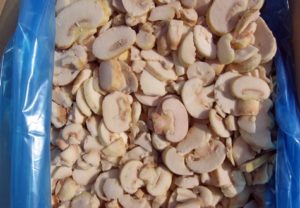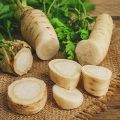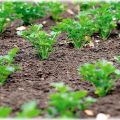TOP 10 best recipes for preparing parsley for the winter at home with and without freezing
In the middle of winter, the human body needs support. Therefore, hostesses from the summer begin to prepare various preparations and snacks for the winter. This is necessary to maintain overall health. Greens are no exception. There are several ways to prepare parsley for the winter. The choice always remains with the housewife.
Why parsley is useful
It is difficult to overestimate the degree of usefulness of greens, since the therapeutic effect on the human body is very great. The multifaceted influence of the constituent elements leads to an increase in the general tone.

The effects of parsley on humans are:
- improving the work of the adrenal glands;
- improving metabolism;
- anti-inflammatory effects;
- strengthening of blood vessels;
- ensuring the normal functioning of the brain;
- improving the condition of the body in diseases of the stomach and duodenum;
- stimulation of digestive enzymes;
- stimulation of appetite;
- the emergence of a feeling of satiety;
- beneficial effect on the organs of vision;
- strengthening the gums and more.
When consuming parsley in any form, do not forget about contraindications. In addition to good, it also brings harm. You should consult your doctor before self-medicating.
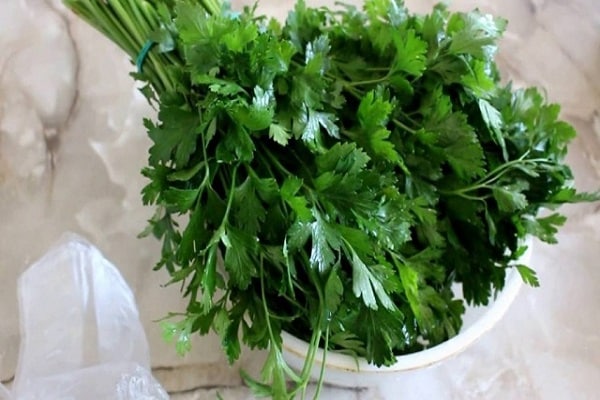
It is undesirable to use parsley for those who:
- suffers from diseases of the bladder, cystitis, urolithiasis,
- has chronic diseases of internal organs,
- has a tendency to allergies.
Everything is good in moderation - no need to abuse, and there will be no harm from the use of culture.
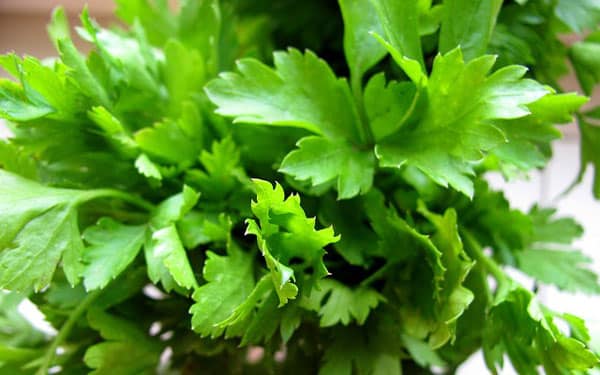
We prepare the necessary ingredients
When collecting greens for storage, it is worth considering several rules under which parsley will retain the maximum useful properties:
- The green part of the plants is harvested at any time. The vitamin reserve concentrated in the leaves does not change in different periods of the growing season.
- The roots are assembled only in the fall, since it is at this time that they are filled with the maximum amount of nutrients.
Before you start harvesting parsley, you need to separate the green part from the rhizome. Sort out all the leaves, removing dry, yellowed specimens.
Wash all components and dry well. Then decide on a method of preservation in the winter. It depends on the time the housewife has at her disposal and the personal preferences of family members.
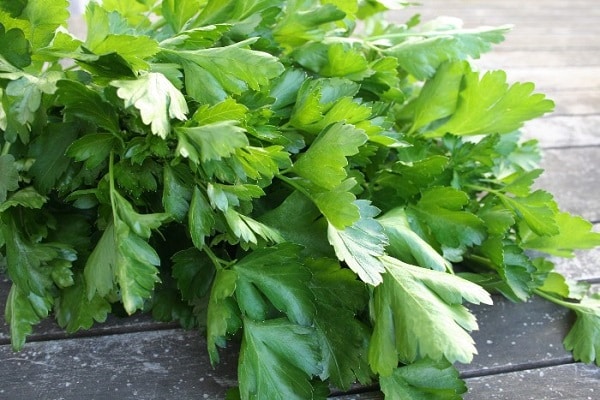
Methods for preparing parsley for the winter
For every housewife, there are recipes suitable for her preferences and wishes. One has only to search a little. It is not difficult to create suitable home conditions for workpieces. And the resulting seasoning compensates for all the energy expended.
For the winter, the whole plant is harvested, there are not many ways to accomplish this task:
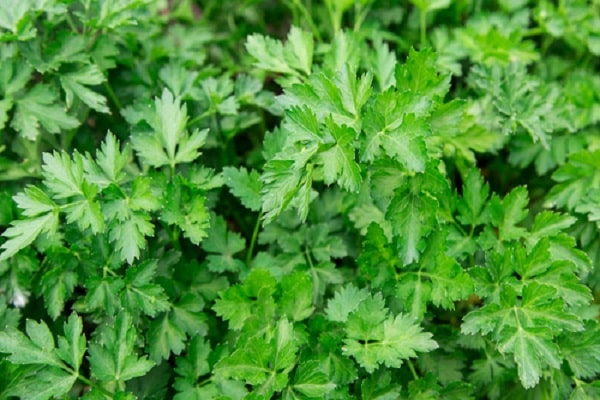
- Drying. The roots and leaves of plants are dried in the oven or in the fresh air.
- Freezing. The crushed parts of the culture are frozen and stored in a freezer.
- Pickling or salting. Chopped greens and chopped roots are pickled or salted.
- Oiling. The billet is mixed with oil and stored in the refrigerator.
You should choose a method for preserving culture by studying the recipes.
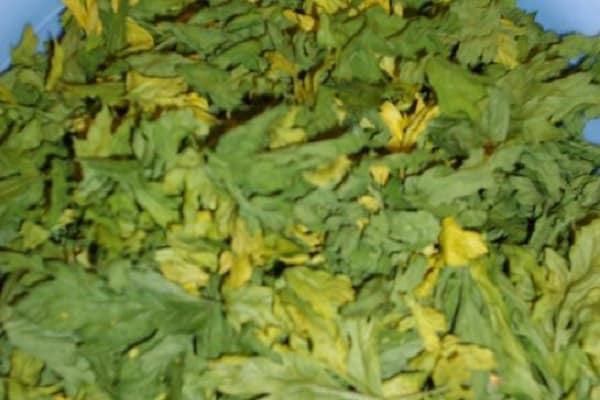
Dried parsley
Nothing hard about dry parsley, not. It is enough to fulfill a few requirements, and everything will work out.
How to dry the plant and preserve the aroma - this question is asked by many housewives. Compliance with the requirements and rules leads to the fact that parsley retains not only smells, but also mineral components.
The advantages of this method are that parsley loses weight and becomes leaner. And it is easier to store it, and it does not require special conditions.

To prepare green mass or roots for future use, they are well washed and dried. Then they sort it out, removing unsightly, sick and deformed specimens. At the end of sorting, the roots are cleaned.
Greens are dried in a whole bunch, together with the lower part of the stem, or each leaf individually.
The roots, depending on the size, are cut into circles or cubes. The prepared raw materials only need to be dried. They do it in different ways.

On open air
This method is long-term, but the effectiveness does not suffer from it. Greens are dried in whole branches or chopped in such a way as for immediate consumption.
For drying, it is placed on a plane, evenly distributing it over the surface on which it is dried. The thinner the layer, the faster the raw material will dry. Lay out no more than 1 centimeter thick.
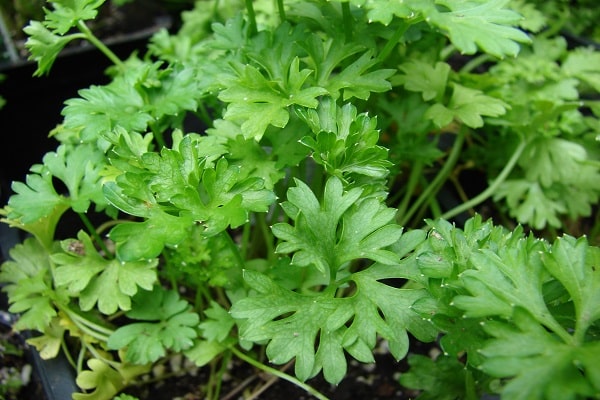
Greens collected in bunches are hung under a canopy or in another well-ventilated area. The leaves should hang down. It is advisable to exclude direct sunlight on the foliage, as it will turn yellow and lose its attractiveness.
The roots are also dried in the open air, chopping in any way and covering with gauze from insects. Turning the pieces over periodically will speed up the drying process and eliminate debate.
Depending on the accompanying conditions, the plant will have to dry from 5 to 20 days, not forgetting to periodically turn the raw material to speed up the process.
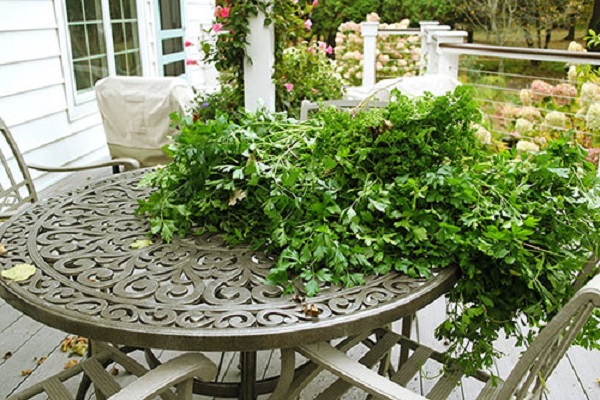
In the oven
It does not take much time to prepare the spice in this way. The seasoning will dry out much faster than in the first case.
Here it is important not to overdo it with the temperature, because the higher it is, the faster the roots and greens dry. But the appearance and the complex of useful substances that make up their composition suffer from this.
The optimum temperature is 40-60 ⁰С. The washed and peeled roots are cut into cubes or slices and laid out on a baking sheet. Greens are laid out in twigs or cut and distributed in a thin layer.
Dry with the door open, the approximate time spent in the oven is 5-6 hours. Finely cut raw materials dry several times faster.
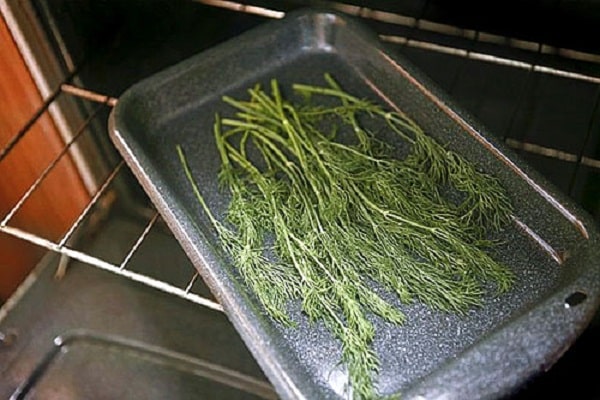
In an electric dryer
This kitchen assistant will always help out the housewife. You don't have to do anything special, the roots must be cut, and the green branches are laid out entirely.
The mode "For herbs" is set, and the temperature is set to no more than 45 ⁰С. It is necessary to periodically monitor the process, swapping the pallets.It is difficult to specify the exact time, it depends on the accompanying factors: air humidity, thickness of the cut and much more.
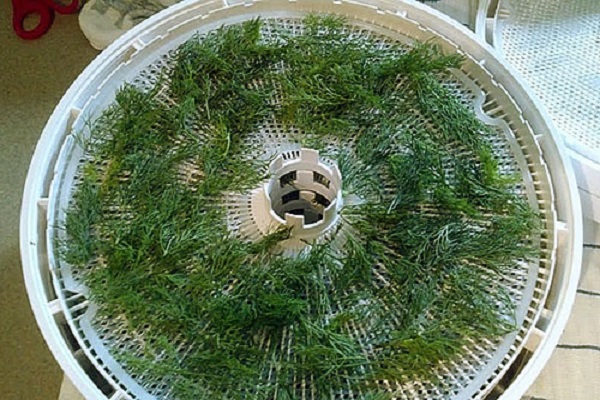
In the microwave
Put the parsley on a plate, preferably flat, cover the bottom with a napkin. The power of the device is maximum. The time for which the raw materials are placed in the microwave is 2 minutes, then you should look at the appearance of the plant. If it is not dry enough, put it on for another 2 minutes. And so on until the mass reaches the desired state.
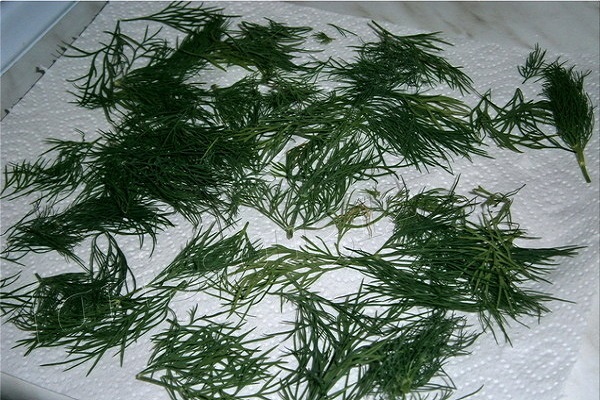
Parsley salting
An effective way to preserve your crop for the winter is to sprinkle with salt. There are many recipes for its preparation. It is required to choose the most suitable method.

Twigs
Salting in this way is not difficult, a minimum of ingredients are used:
- parsley - 400 grams;
- salt 100 grams.
The greens are sorted out, washed with running water and separated from the coarse stems. The prepared glass container is scalded with boiling water. The twigs are mixed with salt so that it is evenly distributed. Then they are laid out in jars and put away for storage. A refrigerator, balcony or other cold room will do.

In the classic way in the bank
The method, proven over the years, preserves the beneficial substances that make up parsley. No additional ingredients are required. All unusual methods take a lot of time to prepare, and this recipe is simple and equally useful.
Components:
- parsley - 300 grams;
- salt 3 tablespoons.
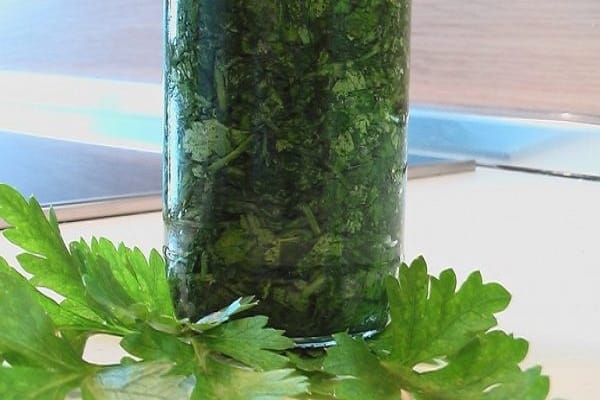
Well-washed greens are wiped off with a towel, chopped and rubbed with salt. The more carefully they do it, the better.
The resulting mixture is tamped into sterile jars and closed with any lids, at the discretion of the housewives.
The lid should close tightly without letting in air. This will prevent signs of spoilage from appearing.
Salted seasoning keeps well in the refrigerator or cellar. Mold may develop at room temperature. Any dishes and salads are prepared with this parsley.

With the addition of dill
To salt parsley with dill, you need a minimum set of ingredients. And the benefits increase several times. The amount of greens is determined by the housewife, it is important to observe only the proportions of salt. If there are more of any raw materials - that's okay.
Components:
- equal amount of dill and parsley;
- salt at the rate of 200 grams per 1 kilogram of green mixture.
The green part of the plants is washed well with water, then be sure to dry. Raw materials are crushed in any convenient way.

Then all the ingredients are combined in a separate bowl, the salt is thoroughly mixed with the green mass. Then they start tamping. If you just fold it, the greens will start to deteriorate. It is necessary not to report a little to the top, leaving a gap between the lid and the seasoning.
To prevent spoilage of the finished product, housewives pour a little more salt on top of the blank.
Banks are kept cold. If they are small and few, then a refrigerator is fine.
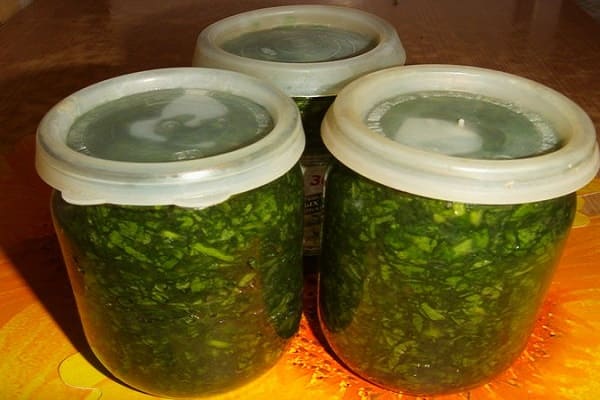
With celery
Everyone is recommended to try to cook this preparation with salt. It turns out a healthy vitamin mixture, perfect for dressing dishes, salads and soups.
Components:
- parsley, celery and dill - 250 grams each;
- salt - 250 grams.

First of all, the green parts of the plants are sorted and washed, be sure to remove all unsightly specimens. Thick stems are cut. Cut into 2 centimeters long pieces.
The celery root is peeled and cut into similar strips. Place in a separate bowl.
First, combine greens and salt, grind well, then add celery roots. All mix well and put in jars. The workpiece should be tamped, then put in the refrigerator.
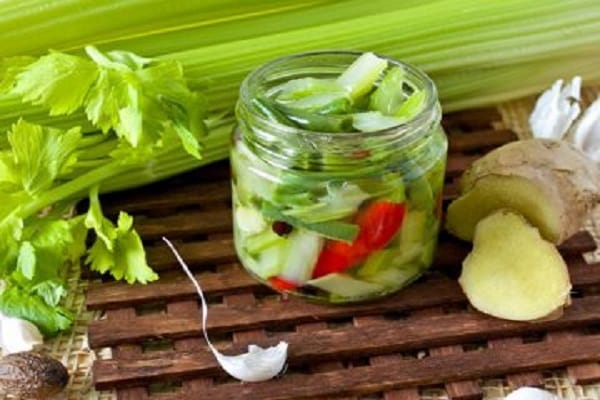
Freezing parsley
An equally effective way of harvesting greens for the winter is freezing. The culture retains the entire supply of nutrients, thereby helping to maintain immunity in the middle of winter.It will take very little time and effort to freeze plants. There are 3 ways, which one is the best, the hostess herself will decide.

In the package
All you need is parsley. The quantity is not limited. The leaves are well washed, sorted and dried.
If the herbs sit for more than 30 minutes, they will begin to wither. This will make it difficult to prepare the workpiece.
Drying using a towel will be quick and effective. Then it should be cut in any way or as for immediate dressing of the dish.
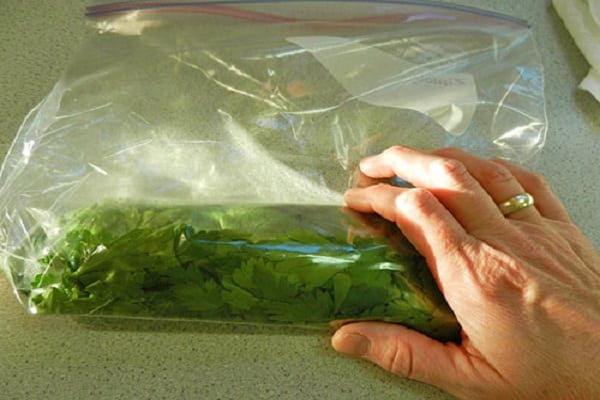
The prepared chopped green mass is laid out in bags. Do not freeze in large quantities, it is not advisable. After repeated defrosting, the leftovers will turn black and will not go to the dressing. Next, the bags should be frozen.
Cubes in ice cube trays
A more laborious way of harvesting greens in the winter. You will need boiled water and herbs.
The parsley is washed several times in cold water. It is not necessary to dry, as it is filled with water. Chop finely, it will be easier to tamp into small cubes.
They are laid out in molds, compacted and filled with chilled water. Put in the freezer for several hours. After the cubes are frozen, take them out of the mold and put them in bags. For convenience, they sign.
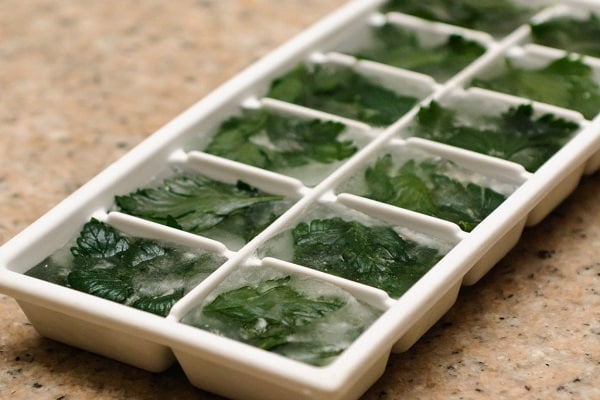
In bunches
This is the fastest way to preserve greens, but you should dry them well. The bunches are formed on the basis of one preparation or two. The leftovers will lie in the refrigerator for several days, no more.
Finished bundles are wrapped in pieces of cling film or put into a plastic bag. And sent to the freezer on demand.

Harvesting fresh parsley in vegetable oil
To properly prepare a dish according to this recipe, you do not need to do anything special. Greens are prepared in the same way as with other storage methods for the winter.
Parsley is chopped and placed in a dry container. In this case, there is no need to ram; then pour in vegetable oil and store the dressing in the refrigerator.
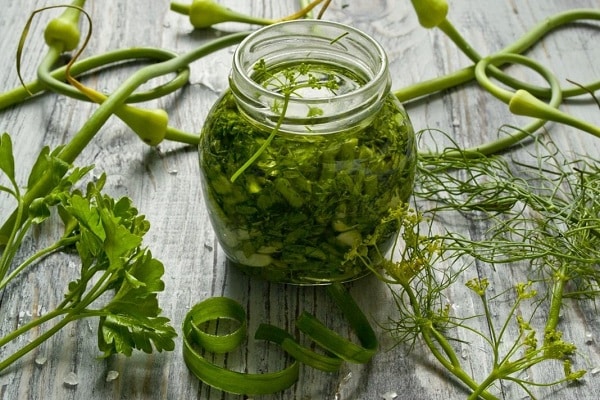
Parsley marinated
The appetizer is made a little more difficult than the previous recipes, since the marinade should be prepared.
Components:
- parsley;
- horseradish, cherry, currant leaves;
- garlic - 2-3 cloves;
- salt, at the rate of 1 tablespoon per liter of water;
- bay leaf, allspice;
- 70% vinegar - 0.5 teaspoon per 1 liter jar;
- water.
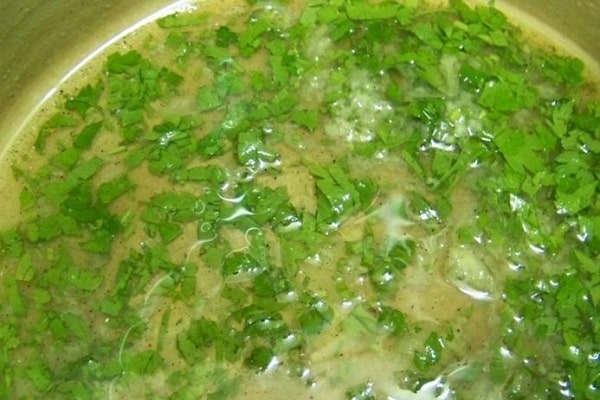
The preparation for the winter should be done like this. Parsley is washed and sorted, cut in an arbitrary way. Spread in jars, with pre-added cherry leaves, currant, horseradish and garlic cloves. Prepare a brine: 1 tablespoon of salt for 1 liter of water. Poured into ready-made jars and closed with lids. Sterilized within 15-25 minutes, depending on the size of the container. They are rolled up and put into the cellar for storage. It is better to prepare such a seasoning in the summer, when the greens are most rich in vitamins.
Canning
Preservation is one of the ways to harvest parsley for a long shelf life. Even a beginner will not have any difficulties with cooking. The main preservative in all recipes is vinegar.
To prepare the workpiece, you will need greens, vinegar and salt directly.
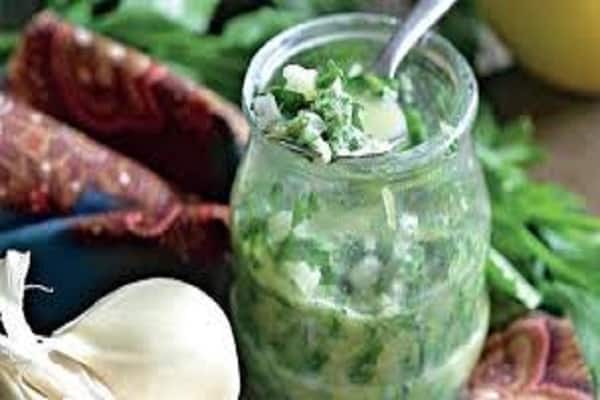
Parsley is cooked like all other recipes. Rinse well and dry. Cut into pieces of 5 centimeters long. They are carefully placed in jars, then the brine is prepared. For 1 liter of water, 1 tablespoon of salt.
Add 2 tablespoons of 6% vinegar to the finished jars and pour in brine. Do not top up to the top, leaving about 2 centimeters.
Placed in a container for sterilization. Boil time is about 10-15 minutes. As soon as they are ready, the cans are rolled up and removed until they cool completely under a blanket or blanket.
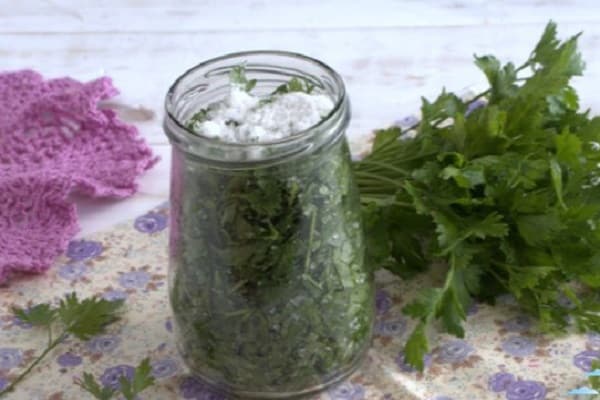
Storage rules
To preserve the workpieces during the winter, simple guidelines should be followed. The storage room should be kept at a constant temperature. The drops should be excluded, this has a bad effect on the spin.
The approximate temperature regime for the preservation of the product is 0 ⁰- + 10 ⁰С.Humidity is 80%.
Frozen greens should not be defrosted and re-frozen, this will cause the mass to turn black and become unsuitable for human consumption.
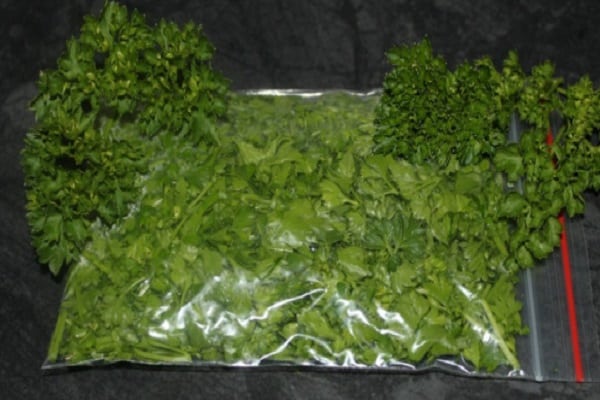
Store dried herbs in a tightly closed glass container in a dark, dry place.
Seasonings prepared according to recipes require a cold storage for long-term storage. A refrigerator, glazed balcony or cellar will do.
Harvested greens, which, if necessary, are always at hand, helps out perfectly in the middle of winter. In addition, it helps to maintain the body during a period of vitamin deficiency.


